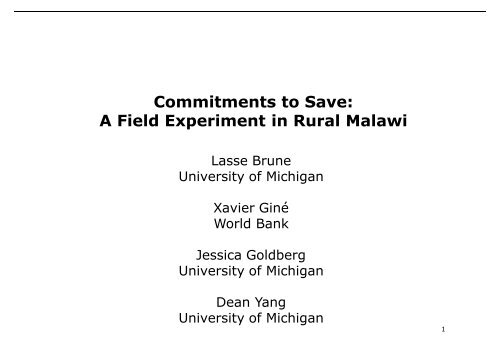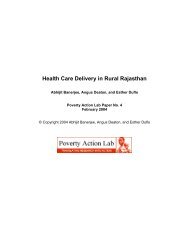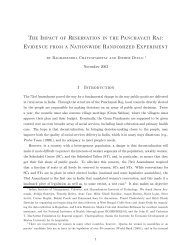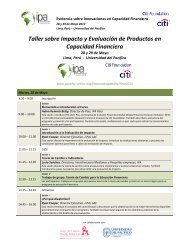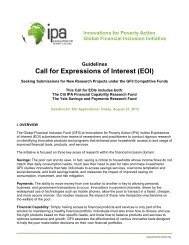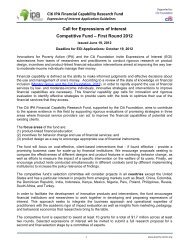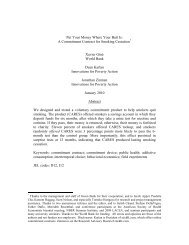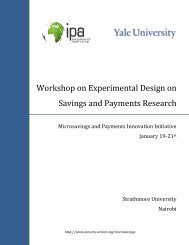Commitments to Save - Innovations for Poverty Action
Commitments to Save - Innovations for Poverty Action
Commitments to Save - Innovations for Poverty Action
You also want an ePaper? Increase the reach of your titles
YUMPU automatically turns print PDFs into web optimized ePapers that Google loves.
<strong>Commitments</strong> <strong>to</strong> <strong>Save</strong>:<br />
A Field Experiment in Rural Malawi<br />
Lasse Brune<br />
University of Michigan<br />
Xavier Giné<br />
World Bank<br />
Jessica Goldberg<br />
University of Michigan<br />
Dean Yang<br />
University of Michigan<br />
1
The mainstays of Malawi’s economy<br />
2
Raising Malawian agricultural productivity<br />
• Government’s main approach <strong>to</strong> raising agricultural<br />
productivity has been large-scale fertilizer subsidies <strong>for</strong><br />
smallholders<br />
– 11% of government budget in 2010/11<br />
– But not sustainable: requires continued donor<br />
support<br />
• An open question: can improvements in rural financial<br />
services improve farmer input utilization without<br />
external subsidies?<br />
3
Raising farm output with rural finance<br />
• For <strong>to</strong>day: results from the 3 rd of a series of<br />
experiments in rural Malawi aimed at raising farm<br />
output via financial service provision<br />
• Insure farmers against adverse events<br />
– Provide insurance against poor rainfall<br />
• Facilitate credit <strong>for</strong> agricultural inputs<br />
– Improve repayment via biometric identification<br />
• Encourage farmers <strong>to</strong> save <strong>for</strong> their own input<br />
purchases<br />
– Facilitate access <strong>to</strong> ordinary and “commitment”<br />
savings accounts<br />
4
Raising farm output with rural finance<br />
• For <strong>to</strong>day: results from the 3 rd of a series of<br />
experiments in rural Malawi aimed at raising farm<br />
output via financial service provision<br />
• Insure farmers against adverse events<br />
– Provide insurance against poor rainfall<br />
• Facilitate credit <strong>for</strong> agricultural inputs<br />
– Improve repayment via biometric identification<br />
• Encourage farmers <strong>to</strong> save <strong>for</strong> their own input<br />
purchases<br />
– Facilitate access <strong>to</strong> ordinary and “commitment”<br />
savings accounts<br />
5
Summary<br />
• Facilitating commitment savings <strong>for</strong> smallholder cash crop<br />
farmers in Malawi has substantial impacts on:<br />
– Savings prior <strong>to</strong> next planting season<br />
– Agricultural inputs applied in next season<br />
– Access <strong>to</strong> funds during next lean (pre-harvest) period<br />
– Crop sales at next harvest<br />
– Food and <strong>to</strong>tal expenditures after next harvest<br />
• Impact of facilitating “ordinary” accounts not as large or<br />
statistically significant<br />
• Impacts likely due <strong>to</strong> reduced sharing with social network<br />
6
Vicious circles in input or credit provision<br />
Provision of<br />
inputs<br />
• E.g., via subsidies or<br />
credit<br />
Higher<br />
harvest<br />
income<br />
Earnings<br />
dissipated<br />
prior <strong>to</strong> next<br />
season<br />
7
Vicious circles in input or credit provision<br />
Provision of<br />
inputs<br />
• E.g., via subsidies or<br />
credit<br />
Higher<br />
harvest<br />
income<br />
Earnings<br />
dissipated<br />
prior <strong>to</strong> next<br />
season<br />
Why do farmers have<br />
trouble maintaining<br />
savings between one<br />
harvest and the next?<br />
8
Increased incomes via savings facilitation<br />
Input purchases<br />
financed by both<br />
credit and<br />
savings<br />
Input purchases<br />
without credit<br />
Saving <strong>for</strong> future<br />
input purchases<br />
Initial provision<br />
of inputs<br />
9
Increased incomes via savings facilitation<br />
Input purchases<br />
financed by both<br />
credit and<br />
savings<br />
Input purchases<br />
without credit<br />
Saving <strong>for</strong> future<br />
input purchases<br />
Focus of this project<br />
Initial provision<br />
of inputs<br />
10
Why might farmers have trouble saving?<br />
• Impatience<br />
– Value the present much more<br />
than the future<br />
• Self-control problems<br />
– Want <strong>to</strong> save <strong>for</strong> future, but<br />
often give in <strong>to</strong> temptation <strong>to</strong><br />
spend now<br />
• Social network makes high demands<br />
<strong>for</strong> sharing of resources<br />
– In<strong>for</strong>mal village insurance<br />
systems<br />
11
Why might farmers have trouble saving?<br />
• Impatience<br />
– Value the present much more<br />
than the future<br />
• Self-control problems<br />
– Want <strong>to</strong> save <strong>for</strong> future, but<br />
often give in <strong>to</strong> temptation <strong>to</strong><br />
spend now<br />
“Psychological”<br />
phenomena<br />
• Social network makes high demands<br />
<strong>for</strong> sharing of resources<br />
– In<strong>for</strong>mal village insurance<br />
systems<br />
12
Why might farmers have trouble saving?<br />
• Impatience<br />
– Value the present much more<br />
than the future<br />
• Self-control problems<br />
– Want <strong>to</strong> save <strong>for</strong> future, but<br />
often give in <strong>to</strong> temptation <strong>to</strong><br />
spend now<br />
• Social network makes high demands<br />
<strong>for</strong> sharing of resources<br />
– In<strong>for</strong>mal village insurance<br />
systems<br />
What our<br />
experiment<br />
potentially<br />
addresses<br />
13
Why might farmers have trouble saving?<br />
• Impatience<br />
– Value the present much more<br />
than the future<br />
• Self-control problems<br />
– Want <strong>to</strong> save <strong>for</strong> future, but<br />
often give in <strong>to</strong> temptation <strong>to</strong><br />
spend now<br />
• Social network makes high demands<br />
<strong>for</strong> sharing of resources<br />
– In<strong>for</strong>mal village insurance<br />
systems<br />
A novel subexperiment<br />
tests this in<br />
particular<br />
14
The agricultural cycle in Malawi<br />
Rainy season<br />
May<br />
June<br />
July<br />
August<br />
September<br />
Oc<strong>to</strong>ber<br />
November<br />
December<br />
January<br />
February<br />
March<br />
April<br />
Harvest<br />
Planting<br />
“Hungry season”<br />
15
The agricultural cycle in Malawi<br />
Rainy season<br />
May<br />
June<br />
July<br />
August<br />
September<br />
Oc<strong>to</strong>ber<br />
November<br />
December<br />
January<br />
February<br />
March<br />
April<br />
Harvest<br />
Planting<br />
Savings<br />
need <strong>to</strong><br />
span this<br />
period<br />
“Hungry season”<br />
16
Key questions<br />
• What is the impact of facilitating access <strong>to</strong><br />
and deposits in<strong>to</strong> savings accounts at the<br />
time of harvest?<br />
• Does provision of “commitment” savings<br />
accounts have greater impacts?<br />
17
Commitment savings<br />
• Idea: allow cus<strong>to</strong>mers <strong>to</strong> voluntarily restrict own<br />
access <strong>to</strong> savings<br />
• In practice:<br />
– Allow cus<strong>to</strong>mers <strong>to</strong> put funds in<strong>to</strong> a special account<br />
where their access is restricted <strong>for</strong> defined period<br />
– Cus<strong>to</strong>mers choose “release date” of funds<br />
• Why might this enhance savings?<br />
– Helps deal with self-control problems<br />
– Also may help resist demands from social network<br />
18
Related past work<br />
• Ashraf, Karlan, and Yin (2006): Offering<br />
commitment accounts in Philippines leads <strong>to</strong> higher<br />
savings<br />
• Dupas and Robinson (2010): Savings accounts<br />
have positive effects on investment and profits<br />
among small market sellers in Kenya<br />
• Duflo, Kremer, Robinson (2010): small incentive <strong>to</strong><br />
buy fertilizer early (right after harvest) has big<br />
effects on subsequent fertilizer use in next season<br />
19
The intervention<br />
• Treatments involve facilitating opening of and deposit<br />
in<strong>to</strong> savings accounts<br />
– Help with account opening procedures<br />
– Direct deposit of cash crop sales in<strong>to</strong> individual<br />
farmer accounts<br />
• Study participants randomly allocated <strong>to</strong> control group<br />
or one of the treatments<br />
• Sample: <strong>to</strong>bacco farmers who are current loan<br />
cus<strong>to</strong>mers of OIBM<br />
• Collaborating institution: Opportunity International<br />
Bank of Malawi (OIBM)<br />
– Exploit existing direct funds transfer system from<br />
central auction system<br />
20
Two types of savings treatments<br />
1. Offer of ordinary savings account only<br />
2. Offer of ordinary plus commitment accounts<br />
21
OIBM savings account details<br />
• By design, other features of ordinary and commitment<br />
accounts are identical<br />
• Interest rate: 2.5% p.a., accrues quarterly<br />
• Account opening fee: MK 500<br />
• No monthly fee<br />
• Minimum balance: MK 1000<br />
• Closing fee: MK 1000<br />
• Maximum of 3 transactions per month w/o fees and MK<br />
25 per transaction thereafter<br />
22
Project timing<br />
Baseline + offer<br />
of savings<br />
accounts:<br />
Apr-May 2009<br />
Endline survey:<br />
Jul-Sep 2010<br />
April<br />
May<br />
June<br />
July<br />
August<br />
September<br />
Oc<strong>to</strong>ber<br />
November<br />
December<br />
January<br />
February<br />
March<br />
April<br />
May<br />
June<br />
July<br />
August<br />
September<br />
2009 harvest<br />
Planting<br />
“Hungry season”<br />
2010 harvest<br />
23
40,000<br />
35,000<br />
30,000<br />
25,000<br />
20,000<br />
15,000<br />
10,000<br />
5,000<br />
0<br />
Deposits, pre-planting<br />
4,685<br />
21,809<br />
35,287<br />
Control Ordinary Ordinary +<br />
commitment<br />
Note: Exchange rate is roughly MK145/USD.<br />
24
40,000<br />
35,000<br />
30,000<br />
25,000<br />
20,000<br />
15,000<br />
10,000<br />
5,000<br />
0<br />
Deposits, pre-planting<br />
4,685<br />
21,809<br />
35,287<br />
Control Ordinary Ordinary +<br />
commitment<br />
40,000<br />
35,000<br />
30,000<br />
25,000<br />
20,000<br />
15,000<br />
10,000<br />
5,000<br />
0<br />
Withdrawals, pre-planting<br />
4,054<br />
21,342<br />
33,161<br />
Control Ordinary Ordinary +<br />
commitment<br />
Note: Exchange rate is roughly MK145/USD.<br />
25
Deposits, pre-planting<br />
40,000<br />
35,000<br />
35,287<br />
30,000<br />
25,000<br />
21,809<br />
20,000<br />
15,000<br />
10,000<br />
5,000<br />
0<br />
4,685<br />
Control Ordinary Ordinary +<br />
commitment<br />
40,000<br />
35,000<br />
30,000<br />
25,000<br />
20,000<br />
15,000<br />
Net deposits, pre-planting<br />
40,000<br />
35,000<br />
30,000<br />
Withdrawals, pre-planting<br />
33,161<br />
10,000<br />
5,000<br />
0<br />
631 467<br />
2,126<br />
Control Ordinary Ordinary +<br />
commitment<br />
25,000<br />
20,000<br />
21,342<br />
15,000<br />
10,000<br />
5,000<br />
4,054<br />
0<br />
Control Ordinary Ordinary +<br />
commitment<br />
26<br />
Note: Exchange rate is roughly MK145/USD.
40,000<br />
35,000<br />
30,000<br />
25,000<br />
20,000<br />
15,000<br />
10,000<br />
5,000<br />
0<br />
40,000<br />
35,000<br />
30,000<br />
25,000<br />
20,000<br />
15,000<br />
10,000<br />
5,000<br />
0<br />
Deposits, pre-planting<br />
4,685<br />
21,809<br />
35,287<br />
Control Ordinary Ordinary +<br />
commitment<br />
Withdrawals, pre-planting<br />
4,054<br />
21,342<br />
33,161<br />
Control Ordinary Ordinary +<br />
commitment<br />
40,000<br />
35,000<br />
30,000<br />
25,000<br />
20,000<br />
15,000<br />
10,000<br />
5,000<br />
0<br />
Net deposits, pre-planting<br />
631 467<br />
2,126<br />
Control Ordinary Ordinary +<br />
commitment<br />
Commitment treatment generates:<br />
• ~$243 in deposits<br />
• withdrawals slightly lower but similar<br />
magnitude<br />
• positive net accumulation<br />
Note: Exchange rate is roughly MK145/USD.<br />
27
• Compared <strong>to</strong> control group, commitment treatment leads <strong>to</strong> 72%<br />
higher agricultural inputs in next season<br />
120,000<br />
Inputs<br />
100,000<br />
97,199<br />
80,000<br />
70,055<br />
60,000<br />
56,519<br />
40,000<br />
20,000<br />
0<br />
Control Ordinary Ordinary + commitment<br />
Note: Dependent variable expressed in Malawi kwacha. Exchange rate is roughly MK145/USD.<br />
28
• Compared <strong>to</strong> control group, commitment treatment leads <strong>to</strong> 72%<br />
higher agricultural inputs in next season<br />
120,000<br />
Inputs<br />
100,000<br />
97,199<br />
80,000<br />
60,000<br />
56,519<br />
70,055<br />
This increase<br />
is statistically<br />
significantly<br />
different from<br />
zero<br />
40,000<br />
20,000<br />
0<br />
Control Ordinary Ordinary + commitment<br />
Note: Dependent variable expressed in Malawi kwacha. Exchange rate is roughly MK145/USD.<br />
29
• … and 61% higher <strong>to</strong>tal crop sales at harvest time<br />
180,000<br />
Crop sales<br />
160,000<br />
161,089<br />
140,000<br />
120,000<br />
117,028<br />
100,000<br />
100,295<br />
80,000<br />
60,000<br />
40,000<br />
20,000<br />
0<br />
Control Ordinary Ordinary + commitment<br />
Note: Dependent variable expressed in Malawi kwacha. Exchange rate is roughly MK145/USD.<br />
30
• As a result, weekly food expenditure is roughly 25% higher in commitment<br />
group at time of post-harvest survey<br />
2,000<br />
Food expenditure (7 day recall)<br />
1,800<br />
1,734<br />
1,600<br />
1,527<br />
1,400<br />
1,384<br />
1,200<br />
1,000<br />
800<br />
600<br />
400<br />
200<br />
0<br />
Control Ordinary Ordinary + commitment<br />
Note: Dependent variable expressed in Malawi kwacha. Exchange rate is roughly MK145/USD.<br />
31
• … and <strong>to</strong>tal expenditure is 31% higher in commitment group<br />
16,000<br />
14,000<br />
Total expenditure (30 day recall)<br />
12,521<br />
14,718<br />
12,000<br />
11,234<br />
10,000<br />
8,000<br />
6,000<br />
4,000<br />
2,000<br />
0<br />
Control Ordinary Ordinary + commitment<br />
Note: Dependent variable expressed in Malawi kwacha. Exchange rate is roughly MK145/USD.<br />
32
• Commitment group withdraws more funds during planting season. May mean<br />
better consumption smoothing during the “hungry” season.<br />
0<br />
0<br />
Net deposits, planting<br />
Control Ordinary Ordinary + commitment<br />
-500<br />
-639<br />
-1,000<br />
-1,500<br />
-2,000<br />
-2,500<br />
-2,440<br />
-3,000<br />
Note: Dependent variable expressed in Malawi kwacha. Exchange rate is roughly MK145/USD.<br />
33
Why does commitment savings help?<br />
• Two alternatives:<br />
1. Solution <strong>to</strong> self control problems<br />
2. Reduces sharing with social network<br />
• Other analyses we have done point <strong>to</strong> #2:<br />
– Impact of commitment savings is higher <strong>for</strong><br />
individuals who make more transfers at baseline<br />
• But little relationship with hyperbolic preferences<br />
– Commitment savings reduces transfers <strong>to</strong> other<br />
households<br />
– Impact of commitment is smaller when others in the<br />
village are given in<strong>for</strong>mation on an individual’s bank<br />
balances<br />
34
Balance revelation treatments<br />
• Other additional treatments, randomized at the outset<br />
as well, test impact of revealing one’s account balances<br />
<strong>to</strong> others in the village<br />
• For these additional treatments, we held a raffle<br />
drawing where each farmer would get 1 raffle ticket per<br />
MK1000 saved as of certain dates (Aug and Oct 2009)<br />
– Farmers know of this at outset<br />
• In these treatments, we randomly varied whether an<br />
individual’s number of raffle tickets were announced…<br />
– in public (in front of other group members)<br />
– in private (out of sight of other group members)<br />
35
Effect of public and private raffles<br />
120,000<br />
Inputs<br />
100,000<br />
97,199<br />
80,000<br />
60,000<br />
56,519<br />
70,055<br />
62,907<br />
71,984<br />
40,000<br />
20,000<br />
0<br />
Control Ordinary Ordinary +<br />
commitment<br />
Ordinary +<br />
commitment, public<br />
raffle<br />
Ordinary +<br />
commitment, private<br />
raffle<br />
36
Effect of public and private raffles<br />
120,000<br />
Inputs<br />
100,000<br />
97,199<br />
80,000<br />
60,000<br />
56,519<br />
70,055<br />
62,907<br />
71,984<br />
40,000<br />
20,000<br />
0<br />
Control Ordinary Ordinary +<br />
commitment<br />
Ordinary +<br />
commitment, public<br />
raffle<br />
Ordinary +<br />
commitment, private<br />
raffle<br />
37
Effect of public and private raffles<br />
Inputs<br />
120,000<br />
100,000<br />
80,000<br />
70,055<br />
97,199<br />
This drop is<br />
statistically<br />
significantly<br />
different from<br />
zero<br />
71,984<br />
62,907<br />
60,000<br />
56,519<br />
40,000<br />
20,000<br />
0<br />
Control Ordinary Ordinary +<br />
commitment<br />
Ordinary +<br />
commitment, public<br />
raffle<br />
Ordinary +<br />
commitment, private<br />
raffle<br />
38
External validity: some caveats<br />
• We do not test impact of direct deposit itself, which may be<br />
important<br />
– Aside from the direct deposits, other deposits in<strong>to</strong><br />
accounts very low<br />
– So not clear that simply setting up commitment accounts<br />
would have high impact without the direct deposit<br />
• Most applicable <strong>to</strong> cash crop farmers where sale proceeds can<br />
be channeled directly in<strong>to</strong> bank accounts by the crop buyer<br />
– Higher income on average than typical farmer<br />
– But also relatively easy <strong>to</strong> access – “low hanging fruit”<br />
• Potentially easy means <strong>for</strong> MFIs <strong>to</strong> raise farm inputs and<br />
incomes <strong>for</strong> current loan cus<strong>to</strong>mers<br />
– Common <strong>for</strong> lenders <strong>to</strong> have direct funds-transfer<br />
arrangements with cash crop buyers <strong>for</strong> loan recovery<br />
– Current loan cus<strong>to</strong>mers can simply be offered direct<br />
deposit of crop proceeds in<strong>to</strong> commitment accounts<br />
39
In sum<br />
• Facilitating commitment savings <strong>for</strong> smallholder cash crop<br />
farmers in Malawi has substantial impacts on:<br />
– Savings prior <strong>to</strong> next planting season<br />
– Agricultural inputs applied in next season<br />
– Access <strong>to</strong> funds during next lean (pre-harvest) period<br />
– Crop sales at next harvest<br />
– Food and <strong>to</strong>tal expenditures after next harvest<br />
• Impact of facilitating “ordinary” accounts not as large or<br />
statistically significant<br />
• Impacts likely due <strong>to</strong> reduced sharing with social network<br />
• Overall welfare impact ambiguous because unclear impact on<br />
others in social network<br />
– Future research should investigate further impacts on<br />
others in social network<br />
40
Extra slides<br />
41
Malawi<br />
• Small, densely populated<br />
– Pop. 13.6 million<br />
• 90% of population works<br />
own smallholder farms<br />
• Main crops:<br />
– Maize (<strong>for</strong> food)<br />
– Tobacco (<strong>for</strong> export)<br />
• Low input utilization in<br />
agriculture<br />
– Especially: fertilizer<br />
42
Measuring impacts<br />
• Outcomes in OIBM admin data and follow-up survey of<br />
farmers (July-Sep 2010)<br />
• Sample: ~1,450 farmers in ~160 farmer clubs<br />
– Randomly divided at start of study in<strong>to</strong> 3 groups<br />
(control + 2 treatment groups)<br />
• Impacts of treatments on:<br />
– Deposits and withdrawals prior <strong>to</strong> planting season<br />
– Agricultural inputs applied during planting season<br />
– Access <strong>to</strong> funds during “hungry” season (preharvest)<br />
– Crop sales at harvest<br />
– Expenditures, post-harvest<br />
43
Regression results: deposits and withdrawals<br />
Impact of treatments<br />
Dependent variable:<br />
Deposits, preplanting<br />
Withdrawals,<br />
pre-planting<br />
Net deposits,<br />
pre-planting<br />
Deposits,<br />
planting<br />
Withdrawals,<br />
planting<br />
Net deposits,<br />
planting<br />
Treatment: ord. + commitment 30,602.42*** -29,107.27** 1,495.15 537.57 -4,187.53** -3,649.96**<br />
(11,749.23) (11,317.28) (1,045.82) (2,033.24) (2,111.40) (1,649.68)<br />
Treatment: ordinary 17,124.17*** -17,288.07*** -163.89 -2,376.15 527.11 -1,849.04<br />
(6,468.04) (6,228.34) (658.63) (1,620.51) (727.23) (1,410.78)<br />
Constant 4,684.75** -4,053.66** 631.09 2,875.68* -1,665.26** 1,210.41<br />
(2,297.42) (1,843.76) (513.70) (1,606.77) (654.71) (1,384.06)<br />
P-value of F-test: treatment<br />
effects identical 0.303 0.352 0.100 0.023 0.022 0.057<br />
*** p
Regression results: outcomes<br />
Impact of treatments<br />
Dependent variable: Inputs (MK) Crop sales (MK)<br />
Food<br />
expenditures<br />
(7-day recall)<br />
Total<br />
expenditures<br />
(last 30 days)<br />
Transfers made<br />
in last year<br />
Transfers<br />
received in last<br />
year<br />
Treatment: ord. + commitment 40,679.66** 60,794.30* 349.60* 3,483.50** -786.33** 329.40<br />
(16,091.17) (31,611.18) (183.96) (1,558.93) (343.78) (624.66)<br />
Treatment: ordinary 13,536.08 16,732.57 143.10 1,286.66 -233.07 1,553.27<br />
(9,677.33) (17,782.38) (152.24) (1,113.50) (426.98) (1,122.56)<br />
Constant 56,518.88*** 100,294.95*** 1,383.97*** 11,234.03*** 2,739.80*** 3,573.03***<br />
(5,143.78) (11,161.70) (104.79) (680.14) (301.75) (418.68)<br />
P-value of F-test: treatment<br />
effects identical 0.119 0.179 0.272 0.187 0.110 0.285<br />
*** p


